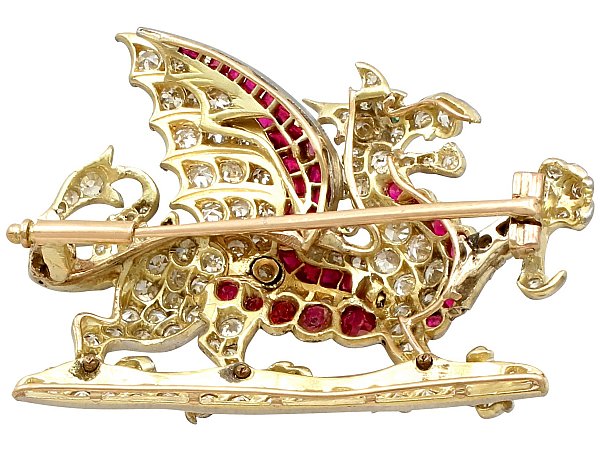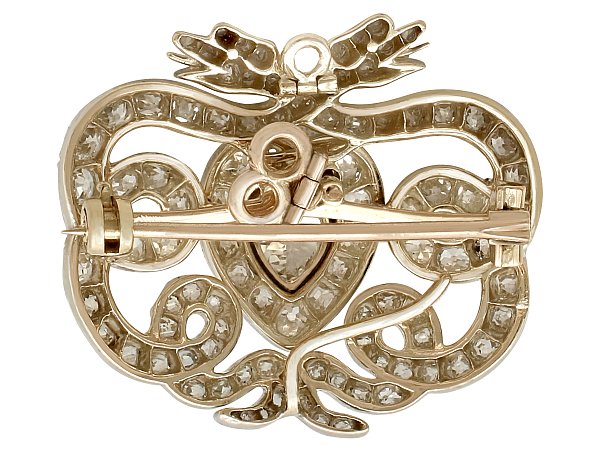Dating jewellery by the style of clasp fastening it has is an essential skill for any jeweller. Sometimes, vintage and even antique jewellery is hallmarked with a date letter. Each year is assigned a letter in a specific typeface, and so identifying the year of production for these pieces is easy enough.
A lot of jewellery, however, isn’t hallmarked. There might be hallmarks indicating the carat quality of the metal used, or sometimes a hallmark that indicates a specific origin, but there isn’t always a date hallmark. When these hallmarks are absent, it’s down to jewellers to use other methods of establishing a date of production.
Enter: clasp fastenings.
What Is a Clasp Fastening?
You may be sat at home right now wondering what I’m talking about, so I’ll explain before we continue. A clasp fastening is the name given to the pins used to affix brooches to garments. The same things are found on badges and safety pins; they just aren’t called the same thing unless they’re part of a piece of jewellery.
Although today most clasp fastenings are made in the same style as your average safety pin, there have been a huge variety of clasp fastenings over the last few centuries. These fastenings have each had their peak periods of usage before the next one rose to prominence. Therefore, we can have a closer look at brooches with those clasps and establish an estimate for when they were made.
Different Types of Clasp Fastening
The main clasp fastenings we’ll look at today are: the C clasp, the trombone clasp, the T bar, and the locking C clasp. There are some brooches with unique clasp fastenings that don’t fit the mould of any of these descriptions, but since they are less widespread, they are less useful to us when dating jewellery.
The C clasp is a staple of the Victorian period. T bar clasps are quite unique because they have no fastener to hold the pin in place. Instead, the metal of the pin is strong and usually longer than the brooch itself. This was so that the brooch could be affixed to the thick and heavy fabrics used in Victorian clothing. As fashion progressed, clasp fastenings needed something to hold the pin in place, and thus the C clasp was born.
C Clasps and Extended C Clasps
There is a clasp fastening usually referred to as the extended C clasp that predates the C clasp with which we’re more familiar. The extended C clasp still has a long and strong pin – longer than the setting of the brooch itself, but it also features the signature ‘c’ shaped metal piece that holds the pin securely. These clasp fastenings were used throughout the Victorian period, particularly for larger brooches. After falling out of use at the turn of the 20th century, the extended C clasp was no longer used. Since the Victorian period, fashion hasn’t dictated the use of such thick fabrics in heavy layers, and so the extended C clasp has had no use.
The C clasp, where the pin was more proportionate to the brooch, is sometimes still used today.
Dating items that feature C clasps, therefore, are sometimes dated using different methods. If they feature gemstones, for example, the way the gemstones are cut can sometimes indicate their age. Old European cut diamonds, for example, indicate a hand-cut stone. Laser cutting was introduced in the first half of the 20th century, and so hand-cut stones can help indicate an age of the item.
What Is a Trombone Clasp Fastening?
Named for the brass instrument that requires back-and-forth motion, the trombone clasp fastening is one you’re likely to recognise. A slim, metal, tubular casing is used to cover the end of the pin. These fastenings were used from the late 1800s through to the mid-20th century. Popular for their safety as well as their security, the trombone clasp fastening was featured on a range of jewellery, but mostly brooches.
This 1920s ruby, emerald, and diamond dragon brooch is a perfect display of the trombone clasp. The trombone fastening is ideal for a brooch this shape and size, as it straddles roughly the centre point of the brooch, holding it firmly and securely in place while wearing.

Locking C Clasps
You’re likely very familiar with the locking C clasp, as they are used today quite frequently. A spinning locking mechanism is attached to the standard C clasp, allowing the wearer to secure the pin of their brooch in place. In terms of their practical use, the locking C clasp is very similar to the trombone clasp. Trombone clasps are generally more difficult to use, however, with the pin mechanism being a little fiddly to pull back. Sometimes, likely due to their age, antique brooches with trombone clasps can be stiff to open. The locking C clasp, therefore, has remained a very popular design choice.
Early examples of locking C clasps have the spinning lock opening downwards. Like the trombone clasp – proves more of a struggle to lock than more modern spinning locks, which lock upwards. Many brooches today are made with the locking C clasp which locks upwards. They are easy to attach and remove, easy to manufacture, as well as being a solid and secure option.

So there you have it, a brief look at some of the clasp fastenings you’re likely to find on antique jewellery. Sometimes, the general design or hallmarks of a piece aren’t enough, and you need to look elsewhere for answers. Have a look at your brooches and see if you can find any luck in establishing their era using the clasp fastenings.








